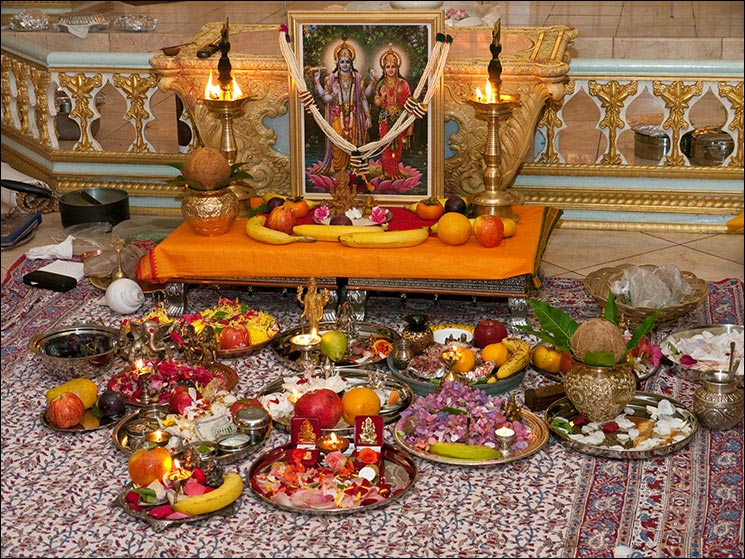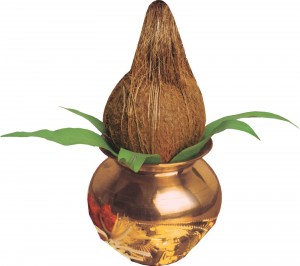
A puja is a religious ceremony performed in temples or in homes that involves worship through the use of a sacred image. At its most basic level of understanding, puja is a symbolic means of communication, a way to reach out to higher powers. There are many ways that we can reach out to divinity: through prayer, meditation, acts of charity, and so forth, but one of the most import and common means is through ritual. In fact, ritual is the foundation of worship and all religions employ rituals as a means to contact the Divine. The Christian Eucharist, the Jewish Seder (passover meal), the Islamic practice of bowing towards Mecca, the Buddhist use of the prayer-wheel and, of course, the Hindu puja are all important uses of ritual that allows a worshipper to communicate with higher powers. The word puja derives from the Sanskrit root puj, to honor or respect.A puja can be short or long, lasting minutes or days, simple or elaborate, involving just the worshipper or many priests and guests, but in every case puja involves the invocation of a Deity as “a guest” in the home, temple or heart of the worshiper. A puja usually employs some kind of sacred image or photo, which serves as a focal point wherein the “spirit” of the Deity is invited to reside for the duration of the ceremony. The sacred image or photo serves as a kind of “receptacle” to house the spirit of the Deity. The image is usually made of metal, wood or, now a days even plastic, but it could even be just a sketch of a Deity drawn on the ground in sand or earth. One can think of the sacred image as an icon that becomes “switch on” or “surcharged” with the spirit of the Deity during the time of puja. Sometimes, instead of using a specific sacred image or photo, just a coconut with leaves in a copper pot is used as a “generic” receptacle. Any God or Goddess can then be invited into this receptacle for the ritual. Puja can be viewed as either the Deity coming down to man and appearing in a form comprehensible to human beings, or man creating a symbolic form of the Deity that is then used to reach out towards the Deity. In other words, puja can be either a descending process or an ascending process. This is a matter of theology and faith.
 Once a particular Deity was been evoked, puja is simply the receiving and adoration of that God or Goddess as a guest. The Deity is then worshiped in a logical and loving manner as one would treat a human guest. A formal puja usually involves 16 separate offerings made to the Deity, but could also involve as many as 27 items of worship or as few as just a couple of items. These items include welcoming and seating of the Deity; washing the feet, hands and mouth; bathing, dressing, ornamentation of the Deity; feeding and worship with incense, lamps and prayers and finally, sending back or releasing the Deity from the receptacle. In its more simple form, puja may only include incense and a lamp. The process is totally malleable and can easily be adjusted to suit the conditions of the worshipper.
Once a particular Deity was been evoked, puja is simply the receiving and adoration of that God or Goddess as a guest. The Deity is then worshiped in a logical and loving manner as one would treat a human guest. A formal puja usually involves 16 separate offerings made to the Deity, but could also involve as many as 27 items of worship or as few as just a couple of items. These items include welcoming and seating of the Deity; washing the feet, hands and mouth; bathing, dressing, ornamentation of the Deity; feeding and worship with incense, lamps and prayers and finally, sending back or releasing the Deity from the receptacle. In its more simple form, puja may only include incense and a lamp. The process is totally malleable and can easily be adjusted to suit the conditions of the worshipper.
Pujas are performed both in temples (mandirs) and in private homes. In temples, they are usually associated with the daily worship of the temple’s sacred images and are performed only by priests. They are also performed on special festival days or upon request of individuals by temple priests. In homes, pujas are performed for special occasions such as anniversaries, graduations, the birth of children, memorial days, or simply for general prosperity and peace within the family. In this case, the family members themselves perform the puja under the guidance of a priest. Commonly performed pujas include Ganesha, Satya Narayana, Durga, and Lakshmi pujas. In fact, a puja can be performed for any God or Goddess or even a combination of Deities. Perhaps the most important part of a puja is the final blessing by the priest and the distribution of prasada at the end. The purpose of a puja is to evoke the presence of a Deity and then to receive the blessing of that Deity. One of the jobs of the priest is to give these blessings. Prasada is the blessed food that has been offered to the Deity during the puja. This food is then offered to all those who have attended the puja. Prasada is the blessing of the Deity.
Hinduism is full of many sacred rituals and colorful ceremonies. These include weddings, the naming of children, hair cutting ceremonies and funerals. Collectively, these ceremonies are called samskaras, rites of passage. Pujas always form the basis of Hindu samskaras and during the course of a marriage, for example, many small pujas will be performed. There may be a dozen pujas contained within the one large marriage ceremony and these pujas involve the invocation of various Gods and Goddess to bless the couple and even the worship of ancestors, pitri-puja, to give blessings to the couple.
Archana
Apart from being a common girl’s name, archana is akin to puja. Technically, archana and puja are the same thing and the words could be interchanged, however, in practice puja generally refers to a more formal “sit down” ceremony, while archana is a ceremony performed by a temple priest on a “walk-in basis.” Typically, a devotee will come to a temple with a basket of fruits and flowers and perhaps a coconut and the priest will offer these items to the Deity on the altar along with a lamp and prayers. The devotee will then receive the food offerings back as a prasada or blessings from the Deity. This is archana.